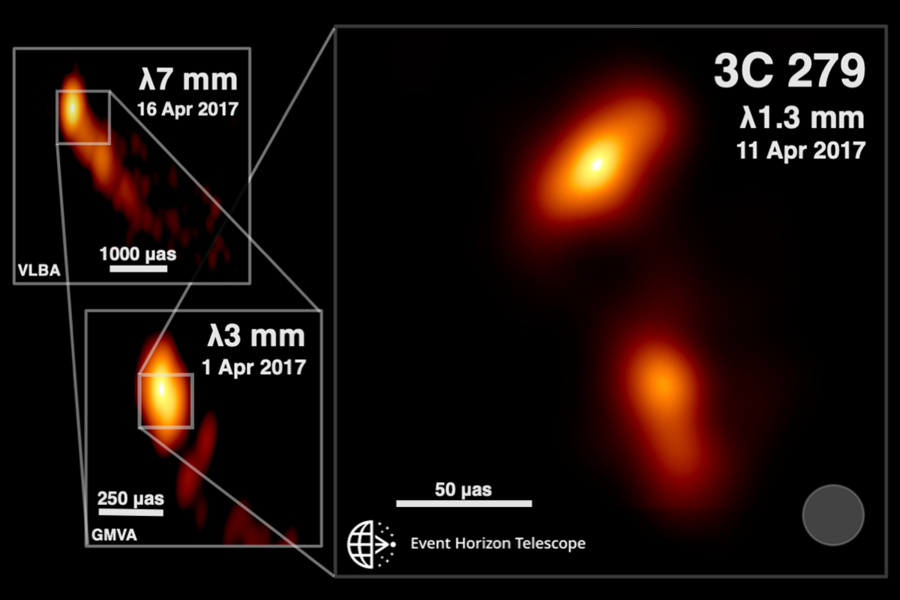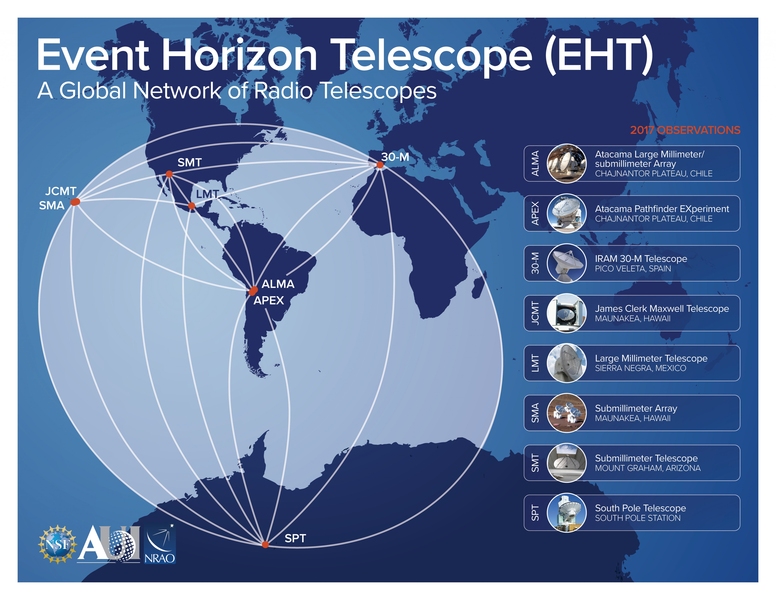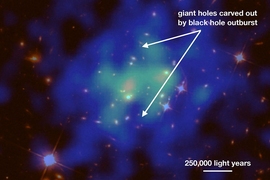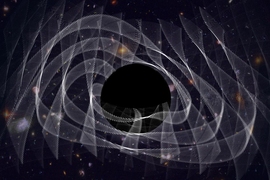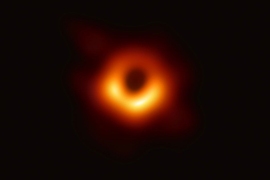One year ago, the Event Horizon Telescope (EHT) Collaboration published the first image of a black hole in the nearby radio galaxy M87. The collaboration has now extracted additional new information from the EHT data on the distant quasar 3C 279, allowing them to image in the finest detail ever a relativistic jet that is believed to originate from the vicinity of a supermassive black hole. New analyses, led by Jae-Young Kim from the Max Planck Institute for Radio Astronomy in Bonn, Germany, enabled the collaboration to trace the jet back to its launch point, close to where violently variable radiation from across the electromagnetic spectrum arises. The results are published in the April 2020 issue of Astronomy & Astrophysics.
The EHT collaboration is continuing to extract information from the groundbreaking data collected in its April 2017 global campaign. One target of the observations was a galaxy 5 billion light years away in the constellation Virgo that scientists classify as a quasar because an ultra-luminous source of energy at its center shines and flickers as gas falls into a giant black hole. This target, labeled 3C 279, contains a black hole about 1 billion times more massive than our sun. Twin fire hose-like jets of plasma erupt from the black hole and disk system at velocities close to the speed of light, a consequence of the enormous forces unleashed as matter descends into the black hole’s immense gravity.
To capture the new image, the EHT uses a technique called very long baseline interferometry (VLBI), which synchronizes and links radio dishes around the world. By combining this network to form one huge virtual Earth-size telescope, the EHT is able to resolve objects as small as 20 micro-arcseconds on the sky — the equivalent of someone on Earth identifying an orange on the moon. Data recorded at all the EHT sites around the world are transported to special supercomputers at MIT Haystack Observatory and MPIfR in Bonn, Germany, where they are combined. The combined dataset is then carefully calibrated and analyzed by a team of experts, which then enables EHT scientists to produce images with the finest detail possible from the surface of the Earth.
For 3C 279, the unprecedented resolution of the EHT reveals fine features of the jet that have never been seen before. In particular, the newly analyzed data show that the normally straight jet has an unexpected twisted shape at its base.
Jae-Young Kim, of the Max Planck Institute for Radio Astronomy and lead author of the paper, is enthusiastic and at the same time puzzled: “We knew that every time you open a new window to the universe you can find something new. Here, where we expected to find the region where the jet forms by going to the sharpest image possible, we find a kind of perpendicular structure. This is like finding a very different shape by opening the smallest matryoshka doll.”
Colin Lonsdale, director of MIT Haystack Observatory and vice chair of the EHT directing board, explains: “This array was developed specifically for the purpose of imaging the shadows of black holes, but as so often happens in science, improved capabilities lead to unexpected discoveries. This surprising result for 3C 279 is a good example, providing new information on the process of jet formation that challenges current understanding.”
“The results are very surprising,” says Kazunori Akiyama, a Jansky Fellow of the National Radio Astronomy Observatory at MIT Haystack Observatory. Akiyama developed imaging techniques for the EHT to create the first images of the black hole in M87; these algorithms were also used to create the images of quasar 3C 279. “When we observed the quasar for four days within one week, we assumed that we would not see these dynamical changes because the source is so far away (100 times further from Earth than M87). But the EHT observations were so sharp that for the first time we could see tiny changes in motions of the jets within this time frame.”
Opportunities to conduct EHT observing campaigns occur once a year in early springtime, but the March-April 2020 campaign had to be canceled in response to the Covid-19 global outbreak. In announcing the cancellation, Michael Hecht, MIT Haystack Observatory astronomer and EHT deputy project director, concluded that: “We will now devote our full concentration to completion of scientific publications from the 2017 data and dive into the analysis of data obtained with the enhanced EHT array in 2018. We are looking forward to observations with the EHT array expanded to 11 observatories in the spring of 2021.”
The individual telescopes involved in the EHT collaboration are: the Atacama Large Millimetre Telescope, the Atacama Pathfinder EXplorer, the Greenland Telescope (since 2018), the IRAM 30-meter Telescope, the IRAM NOEMA Observatory (expected 2021), the Kitt Peak Telescope (expected 2021), the James Clerk Maxwell Telescope, the Large Millimeter Telescope, the Submillimeter Array, the Submillimeter Telescope, and the South Pole Telescope.
The EHT consortium consists of 13 stakeholder institutes: the Academia Sinica Institute of Astronomy and Astrophysics, the University of Arizona, the University of Chicago, the East Asian Observatory, Goethe-Universität Frankfurt, Institut de Radioastronomie Millimétrique, Large Millimeter Telescope, Max-Planck-Institut für Radioastronomie, MIT Haystack Observatory, National Astronomical Observatory of Japan, Perimeter Institute for Theoretical Physics, Radboud University, and the Smithsonian Astrophysical Observatory.
